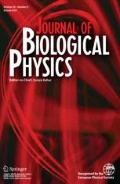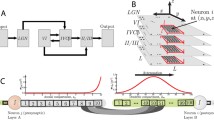Abstract
We theoretically investigate pattern formation during simple visual hallucinations caused by epileptic activity. To this end we analyze the activator-inhibitor model of Ermentrout and Cowan [1]. In contrast to these authors we focus on a different disease mechanism: According to experimental findings (cf. [2]) we decrease the influence of the inhibitor on the activator. This causes spontaneous pattern formation due to a bifurcation. The model parameters determine whether one or two or four modes become unstable. By means of the center manifold theorem, in all cases the order parameter equation is derived, the stability of the solution is proofed, and the bifurcating activity pattern is calculated explicitely in lowest order. Taking into account terms up to third order in all cases the order parameter equation has a potential. For the two-modes and the four-modes instability this potential causes a winner-takes all dynamics. We integrate the order parameter equation numerically and plot the visual hallucinations which result from the bifurcating cortical activity. The theoretically derived hallucinations correspond to clinically observed visual hallucinations (cf. [3, 4]), which are, for instance, well-known from petit mal epilepsy [5].
Finally we investigate the influence of noise on the activity patterns as well as the visual hallucinations.
Similar content being viewed by others
References
Ermentrout, G.B., Cowan, J. (1979) A mathematical theory of visual hallucination patterns,Biol. Cybern. 34, 137–150.
Klee, M.R., Lux, H.D., Speckmann, E.-J. (eds) (1991)Physiology, Pharmacology and Development of Epileptogenic Phenomena, Springer, Berlin, Heidelberg, New York.
Klüver, H. (1967)Mescal and Mechanisms of Hallucination, University of Chicago Press.
Siegel, R.K., West, L.J. (eds) (1975)Hallucinations, Wiley, New York.
Horowitz, M. J., Adams, J.E., Rutkin, B.B. (1967) Evoked hallucinations in epilepsy,Psychiatr. Speculator 11, 4.
Haken, H. (1977)Synergetics, An Introduction, Springer, Berlin, Heidelberg, New York, 1977.
Murray, J. D. (1989)Mathematical Biology, Springer, Berlin, Heidelberg, New York.
Winfree, A.T. (1980)The Geometry of Biological Time, Springer, Berlin, Heidelberg, New York.
Cowan, J.D. (1977) Some remarks on channel band widths for visual contrast detection,Neurosci. Res. Bull. 15, 492–515.
Cowan, J.D. (1987) Brain mechanisms underlying visual hallucinations, in Paines, D. (ed),Emerging Syntheses in Science, Addison-Wesley, New York, pp. 123–131.
Schwartz, E. (1977) Spatial mapping in the primate sensory projection: Analytic structure and relevance to perception,Biol. Cybernetics 25, 181–194.
Kelley, A. (1967) The stable, center-stable, center, center-unstable and unstable manifolds,J. Diff. Equ. 3, 546–570.
Pliss, V. (1964) Principal reduction in the theory of stability of motion,Izv. Akad. Nauk. SSSR Math. Ser. 28 1297–1324.
Haken, H. (1983)Advanced Synergetics, Springer, Berlin, Heidelberg, New York.
Haken, H. (1991)Synergetic Computers and Cognition, Springer, Berlin, Heidelberg, New York.
Hirsch, M.W., Smale, S. (1974)Differential Equations, Dynamical Systems, and Linear Algebra, Academic Press, New York.
Markus, M., Schepers, H. (1992) Pattern formation in neural activator-inhibitor networks, in Müller, S.C., Plesser, T. (eds),Contributions to the Dortmunder Dynamische Woche June 1992, Projekt-Verl., Dortmund.
Author information
Authors and Affiliations
Rights and permissions
About this article
Cite this article
Tass, P. Cortical pattern formation during visual hallucinations. J Biol Phys 21, 177–210 (1995). https://doi.org/10.1007/BF00712345
Received:
Revised:
Issue Date:
DOI: https://doi.org/10.1007/BF00712345




